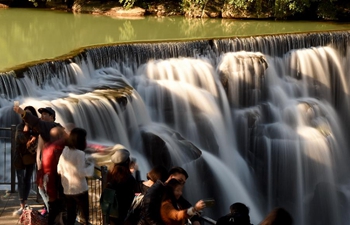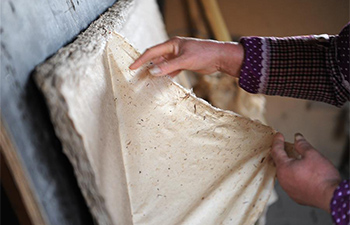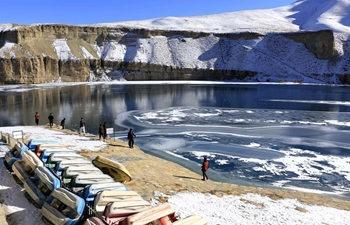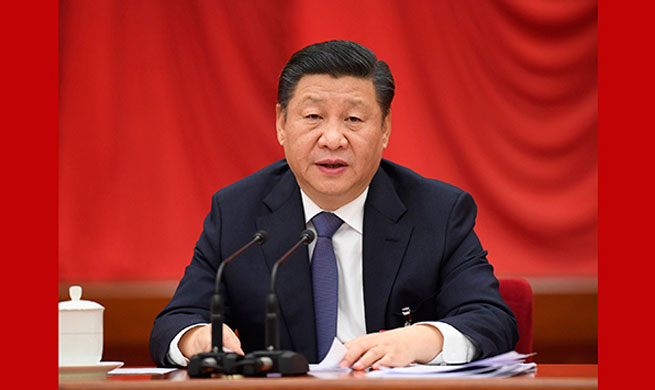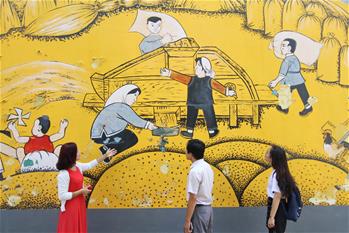TIJUANA, Mexico, Jan. 21 (Xinhua) -- Tijuana resident Alexis Franco is so used to the rusty metal fence that separates this northern Mexican city from its U.S. counterpart San Diego, which he sometimes scales it for fun.
"Mexican power!" he yells one day from the top of the fence, as his girlfriend Guadalupe looks on from the doorway of their small ramshackle home located a few steps away, in a poor neighborhood in east Tijuana.
"I have jumped over, but just as a joke. I jump over, then I jump back," says Franco, 22 year-old.
Since October, the couple have also been living alongside eight prototypes of a proposed wall that U.S. President Donald Trump has pledged to build along the 3,200-kilometer border that the two countries share.
Some of the prototypes look like slabs of concrete, others combine cement with metal tubing, but all are designed to be difficult, if not impossible, to scale.
A year to the day since Trump moved to the White House on Jan. 20, 2017, these nine-meter-high prototypes are the only tangible signs of the "big, beautiful" border wall he wants to build to essentially keep out undocumented migrants and also illicit drugs.
The U.S. Congress has so far refused to earmark the approximately 18 billion U.S. dollars needed to build the wall, despite Trump's insistence that Mexico will somehow be made to foot the bill.
Either talks of the wall or the sight of the prototypes seem to faze Tijuana residents, who have learned since 1994 to live with the 23-kilometer fence that divides the two cities.
Portions of the border to the west are separated by two, sometimes three fences that rise and fall with the hilly landscape. Border patrols, floodlights and surveillance cameras bolster the security efforts.
Franco, who ekes out a living collecting recyclable plastic, said he's not concerned by the proposed wall. So far, the only impact is that tourists and curious onlookers have been showing up on his street to take pictures of the prototypes through slits in the fence.
Adrian Lopez, a neighbor who has lived near the wall since he was deported from Los Angeles 18 years ago, said, "It doesn't affect us at all. They are in their country and they have the right to do what they want in their country, as long as they don't want us to pay for the wall they want to build."
Lopez, 38, grew up as an undocumented migrant in Los Angeles in the western U.S. state of California. He said he prefers living in Mexico, even though he only makes 2,000 pesos (106 U.S. dollars) a week working as a construction worker, enough to "eat poorly."
A border wall will not be able to keep out migrants fleeing poverty and pursuing the American Dream, he said, just as the fence built during the Bill Clinton administration has failed to stem the flow of illegal crossings.
Franco said, "I have recently seen many people jump over from this spot (in front of the prototypes) ... I don't know if they get across, but they jump over as if to say I don't care how big a wall you build, from here to the sky, we are going to cross anyway."
In the 1990s, the Tijuana-San Diego area was where half of undocumented migrants crossed over, according to a study by the College of the Northern Border.
The fence and stepped up patrols reduced the flow, but failed to stop it, pushing it further inland and towards more remote, more dangerous routes through the dry desert of the southern U.S. state of Arizona.
Since the 2001 terrorist attacks took place on the U.S. soil, the U.S. government has attempted to bolster border security, says Rodulfo Figueroa, a National Immigration Institute (INM) delegate for the state of Baja California, where Tijuana is situated.
Wire fencing of up to nine meters high in places stretches along more than one thousand kilometers, or a third of the border.
"Talking about fences or walls is probably a useful political tool, but the reality is that immigration has different aspects," said Figueroa, noting the problem is more complex than a mere border barrier can fix.
Reginaldo Marquez, who lives near the fence, says putting up barriers and stepping up security and patrols have made a difference, mainly to those who charge to smuggle migrants across the border. Their prices have gone up.
Poor Mexicans and Central Americans desperate to improve their lives will not be deterred by a fence, and will scrape together the money needed to pay smugglers, or strike out on their own, said Marquez.
"If the drug traffickers can build tunnels or caves, people are going to find a way" to get across, he said.




